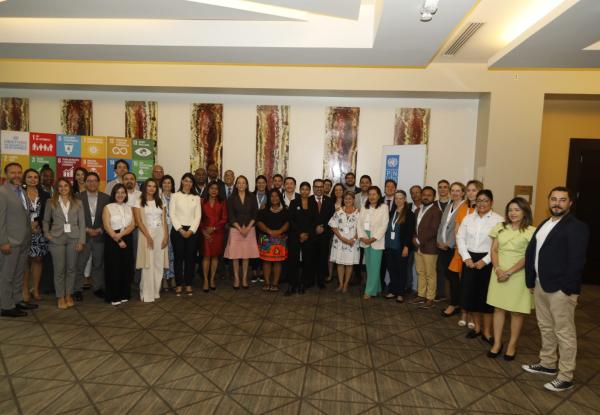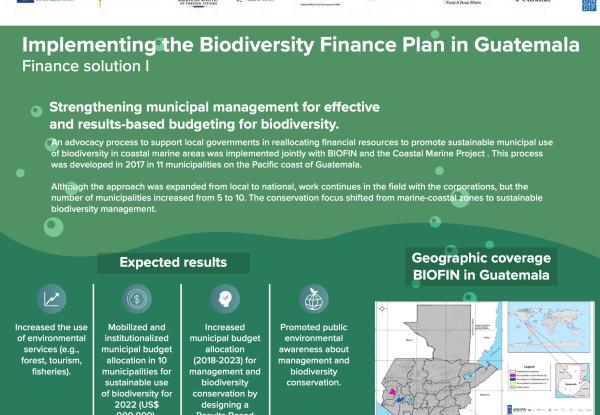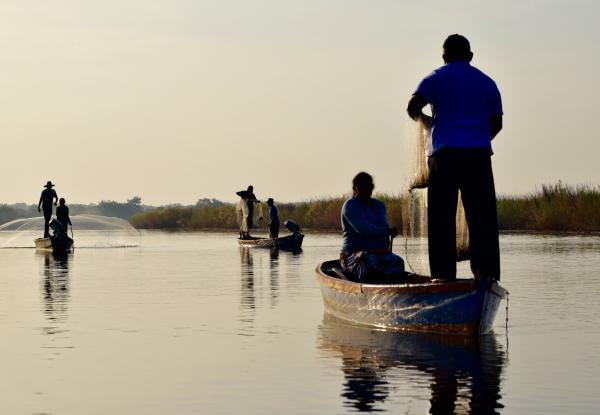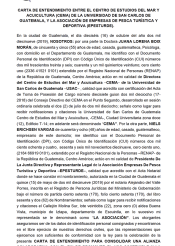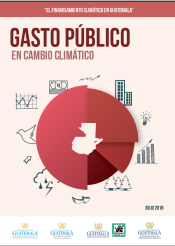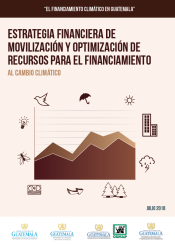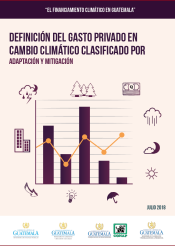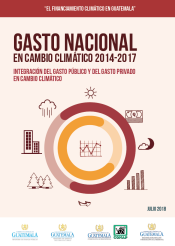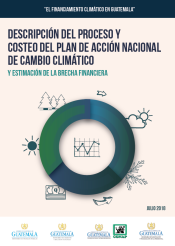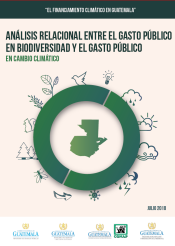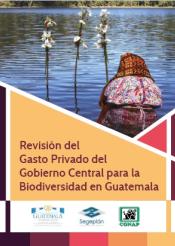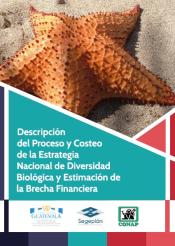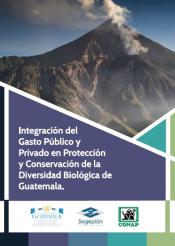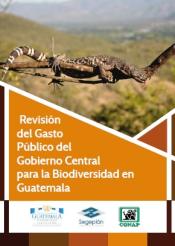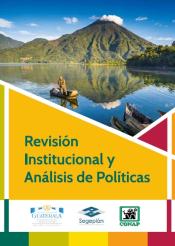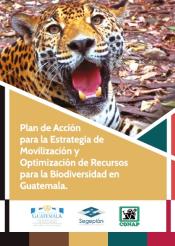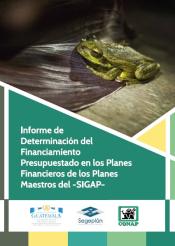Guatemala
The country has high ecological diversity. It has been determined by the variation in altitude and rainfall. The biodiversity is abundant, ranging from the Pacific and Atlantic Coastal Marine Zones (sea level) to the highland mountains and volcanoes. The rainfall variation is also an important factor, as areas in the dry corridor might receive 500 mm/year while the more humid ecosystems receive up to 6,000 mm/year. All this variation in an area of 108,889 km² 1.
According to the Holdridge system, there are ten physiographic regions, 7 biomes, 14 ecoregions, 66 ecosystems, and 14 life zones. Guatemala's floral diversity currently has 321 families, 2,478 genus, and 10,317 species (including algae, lichen, mushrooms, and hepatic plants). 823 species represent some type of endemism, and 538 are restricted to Guatemala.
Regarding fauna, there are 192 species of native mammals, 486 species of birds (only those that reproduce in Guatemala); herpetofauna is very rich, that much that Guatemala has the most significant diversity of Amphibians Plethodontidae (salamander without lungs) in the world (41 species, 19 endemics.)
To protect these resources the country has developed The Protected Areas National System (SIGAP), representing 33% of the territory. This legal mechanism provides safety measures to these areas reducing deforestation and illegal hunting.
Guatemala's economy is highly dependent on agriculture and its related productive processes (21% of GDP)2 as one of the main sources of income and livelihoods for poor populations. Particularly for rural populations. This has led to greater exploitation of natural resources and biodiversity, increasing the risk of degradation, contamination and/or loss. Action and investments are still required to achieve natural resources and biodiversity conservation, and sustainable management.
BIOFIN Guatemala is working to mobilize funding through financial instruments to promote sustainable biodiversity management.
Since 2017, BIOFIN has implemented a Finance Solution (FS) related to results-based budgeting (PPR) with local governments on the Pacific coast to reorient municipal budgets towards coastal-marine biodiversity management, redirecting 766,969 dollars biodiversity management and conservation investments. With the support of the Partnership for Action on Green Economy Initiative - PAGE-, and Ministry of Public Finance (MINFIN) BIOFIN has improved municipal capacities by applying the Classification Guideline for municipal environmental expenditure, which will strengthen the Environmental Fiscal Strategy -EFA-. Finally, BIOFIN is developing actions to create a new mechanism to increase the funds to invest in biodiversity and climate change at a national level, reduce the national debt and create awareness among the population, which will be achieved by designing a debt-for-nature swaps mechanism.
Finance Solution 1: Strengthening municipal management for effective and results-based budgeting for biodiversity. This financial solution aims to mobilize economic resources for Coastal-Marine Biodiversity Management; strengthen municipal capacities related to the Results-based budget (RBB), and redirect/increase ten municipalities' budgets, specifically on the Biodiversity Management budget line.
Finance Solution 2: Strengthening the implementation process of the Social – Environmental Fund for the conservation of Sailfish and Artisan Fishing development (FOPESCA). This is a public-private alliance between the Association of Tourist and Sport Fishing Companies -EPESTURDE- and -CEMA-, the Center for Marine and Aquaculture Studies of the University of San Carlos. Both entities, with the support of BIOFIN, created the Socio-environmental Fund for Sailfish Conservation and Artisanal Fishing Development (FOPESCA). The mechanism receives voluntary contributions from touristic sport anglers, and collected revenues will finance projects related to sustainable artisanal fishing, research, and conservation of Sailfish.
Finance Solution 3: Feasibility study for a debt for nature swap in Guatemala. Guatemala's Ministry of Finance is promoting the development of a debt for nature swap. It will be developed through two phases. The first phase consists of a feasibility analysis to develop the financial solution, and the second phase is the accompaniment in the negotiation process and subsequent approval.
This document comprises two main sections. Firstly, an Institutional Review identifying leading entities and positive and negative impacts to biodiversity derived from their actions was developed. Secondly, a Policy Analysis identifying biodiversity Plans, Projects or Programs and how they are related in terms of adequacy or deficiency towards a sustainable use in ecosystem was undertaken. This Analysis constitutes a Base Line for the construction of the public and private expenditure review and the BIOFIN process. It is grounded in 4 BIOFIN expenditures categories: 1) Mainstreaming and Sustainable use,2) Protection, 3) Restoration and 4) Access and Benefit Sharing. A standardization was made between BIOFIN categories and National Strategies Main implementing partners were grouped into two groups: 1) Public and 2) Private sector. For Public Entities: Ministry of Environment and Natural Resources (MARN), Ministry of Agriculture, Livestock and Food (MAGA), National Forest Institute (INAB) and National Council of Protected Areas (CONAP) are directly related with the four categories of expenditure. Conversely, Ministry of Communications, Infrastructure and Housing (MICIV) and Ministry of Energy and Mines (MEM) are related to negative impact to biodiversity and the four categories of expenditure. For Private entities: NGOs have a positive impact as Biodiversity and environmental Management are part of their objectives. Some associations related to commodities have positive impact such as AZASGUA (Sugar) GREPALMA (African Palm) and ANACAFE (Coffee) but also provide negative impact as these are wide spread monocultures that occupy a vast extension of national territory.
Expenditure Review associated with Biodiversity
Private Expenditure
The expenditure review was estimated by using the SCAEI (Integrated Environmental and Economic Accountability System) that allows to know the total amount of finance resources that are designated for biodiversity-related actions. The 2010-2014 Private Expenditure in Biodiversity is $110 million representing 76% of Environmental Private Expenditure ($143.7 million). Financial resources were mainly invested for protecting biological diversity and landscapes (58%-70%) and research (3%-12%) International cooperation and the Productive Sectors met the greater expenditure: $53 million and $63 million respectively. Meantime, ONGs and Universities spent $28 million. The analyses also estimated expenditure through the national territory which evidenced that the Departments of El Petén and San Marcos are ones with greater expenditure (21% each), more than $30 million. Santa Rosa, Huehuetenango and Izabal showed an expenditure from 5 to 10%. Other departments didn´t spend more than 3.8%.
Public Expenditure
This document describes how Government Expenditure on Biodiversity contributes in the implementation of the National Biodiversity Strategy. This analysis involved the following government institutions: Ministry of Agriculture, Livestock and Food (MAGA), Municipalities National Association (ANAM), Tourism Guatemalan Institute (INGUAT), National Forest Institute (INAB), National Council of Protected Areas (CONAP), Ministry of Environment and Natural Resources (MARN), registered NGOs and History and Anthropology Institute (IDAEH). It also compares expenditure between central and local level governments.The expenditure covered 2006-2014 and was obtained from the Integrated Accountability System, according to the tag “Biodiversity and Landscapes Protection”. Three groups were analyzed: Central level government, Local level government and Total Public Expenditure that is the sum of the former two. The total expenditure in Biodiversity was estimated between $37.74 million to $53.65 million. 92.5% was spent by Central Level Government entities such as CONAP, meanwhile 7.5% was spent by municipalities.
Expenditure Review associated with Climate Change
Private Expenditure
This document presents the results of the analysis on private expenditure associated with climate change. This study combined and adapted the UNDP Climate Public and Institutional Review Methodology, the OECD methodology and the Biodiversity Financing Project (BIOFIN) methodology. An important strategy used to achieve adequate results is the participation and leadership of representatives of the international cooperation, the private sector, non-governmental organizations, the academic sector and private institutes environment management-related. This process was adequately carried out by using the National Action Plan on Climate Change (PANCC) as a fundamental guide. The main findings revealed that the largest amount of financial resources for adaptation and mitigation was provided by the private sector in 2016 (Q 4,202.8 million). On average, 22% of the expenditure is assigned to adaptation and 78% to mitigation-related activities. The difference is based on the significant raise in expenses in the dimensions of Agriculture, Livestock and Food Security and Integrated Management of Water Resources in the adaptation component. Regarding mitigation component the variation is identified in the Energy dimension. By 2016, the private sector was the most important contributor to adaptation and mitigation actions, followed by the international cooperation. However, it is important to mention that the share of private spending on climate change in relation to GDP remains on average in 0.64% over the years 2015-2017. It is expected that this information will support public policy, enhance the leverage of new financial resources and serve as an input to the process of reporting expenditure that have already been committed by the country in its Nationally Determined Contributions (NDC) and in the actions and goals contained in the National Action Plan of Climate Change (PANCC).
Public Expenditure
The document "Public Expenditure on climate change", describes the actions to measure the budget percentage spent by government institutions to reduce the vulnerability to Climate Change. The Ministry of Public Finance (MINFIN), as a part of its duties, has been improving the construction of multiyear institutional budget in five priority sectors, where Climate Change is listed. The document analyses the public expenditure on climate change for previous years. This analysis was developed considering the following government institutions: Ministry of Health, Public and Social Assistance (MSPAS), Ministry of Agriculture, Livestock and Food (MAGA), Ministry of Energy and Mines (MEM), the National Commission for Disaster Reduction (CONRED), the Authority for the Sustainable Management of the Amatitlán Basin and Lake (AMSA), National Forest Institute (INAB), National Council of Protected Areas (CONAP), Ministry of Environment and Natural Resources (MARN), the Authority for Sustainable Management of the Lake Atitlán Basin and its surroundings (AMSCLAE), municipalities and Development Councils. The National Action Plan on Climate Change (PANCC) was used as the main reference to undertake such analysis.
One of the main findings of the expenditure analysis showed that during 2014-2017, the estimated public expenses on adaptation and mitigation reached an annual average of Q. 644.20 million, and the most active institutions in the employment of the budget for climate change actions are: INAB, CONAP, MARN, CONRED and MAGA. These entities have above 84.9% of the total expenditure. Conversely, the analysis indicates that central government has allocated more resources on adaptation (68%) than on mitigation (32%). Regarding the municipalities and the Development Councils, who have a regulatory framework that enables them to allocate the budget, this study revealed that financial allocations are not aligned with the dimensions of the PANCC. It is noteworthy to mention that this exercise is a proxy of the national expenditures on climate change. Finally, the document presents the financial mobilization proposals of the prioritized institutions and the main challenges to monitor and improve national expenditure on climate change.
Relation between Expenditure associated with Biodiversity and Climate Change
This report presents the results of the Relational Analysis between the Public Expenditure on Biodiversity and the Public Expenditure on Climate Change. The report describes the Legal and institutional framework regarding biodiversity and climate change, information related to public financing of biodiversity, and a description of the climate change financing in the country.
The methodology used to measure public spending on biodiversity is different from the one used to measure public spending on climate change. The budget account entry of Environmental Protection Expenditure in the Integrated Accounting System of the Ministry of Public Finances (numeral 6- Expenditure on Biodiversity and Landscapes) was used for Biodiversity expenditure analysis. Regarding Expenditure on Climate Change, such entry identification does not exist. Nevertheless, Expenditure on climate change was identified in conjunction with the government institutions using the adaptation and mitigation criteria from the National Action Plan on Climate Change (PANCC). The report contributed to identify the institutions where correlation between the expenditures on biodiversity and climate change for the analyzed period exists. This correlation was observed in the following institutions: Ministry of Environment and Natural Resources (MARN), Ministry of Agriculture, Livestock and Food (MAGA), National Forest Institute (INAB), National Council of Protected Areas (CONAP), Authority for the Sustainable Management of the Amatitlán Basin and Lake (AMSA), Authority for the Sustainable Management of the Lake Atitlán Basin and its surroundings (AMSCLAE). MAGA and MARN showed an outstanding performance, as these institutions showed a higher percentage of expenditure in relation to the others and both allocated the expenses in biodiversity and climate change.
- Revisión del Gasto Privado del Gobierno Central para la Biodiversidad en Guatemala
- Revisión del Gasto Público del Gobierno Central para la Biodiversidad en Guatemala
- Gasto Público en Cambio Climático
- Análisis relacional entre el gasto en biodiversidad y el gasto público en cambio climático
- Definición Del Gasto Privado En Cambio Climático Clasificado Por Adaptación Y Mitigación
Costs for implementing the National Biodiversity Strategy (NBS)
The document describes the process of costing of the National Biodiversity Strategy (NBS) and the estimation of the financial gap. The methodology of costing included the following steps: a) Collecting Information, b) Identification of budget lines for costing c) Identification of methodologies for costing, d) Systematization and standardization of the collected data and e) Analysis. The total cost of the NBS for the period 2016-2022 is US $ 82.13 million, with an estimated financial gap of $ 66.23 million (80%). Annually $9.5 Million is required to be spent in Biodiversity related actions in order to cover the costs of basic requirements. It also included Investment Costs $ 7.17 Million (10.5%) and Operational Costs $61 Million (89.5%).
Costs for implementing the National Action Plan on Climate Change (PANCC)
The document describes the process of costing the implementation of the National Action Plan on Climate Change (PANCC), and to identify the financial gap. The methodology of costing PANCC required the following aspects: a) to search and build assumptions, b) to develop instruments that allow information to be collected, and c) to transfer the data to an economic language. These aspects were used to establish standard procedures for costs, expenses and investments. . Costing exercises provide an indicative quantitative basis, through which new financial mechanisms, financial gaps can be identified, and mobilization of additional resources can be also identified. In addition, it also helps to provide useful information for the development of viable policies and programs, determine priorities, and incorporate them into public planning and budgeting systems. The total cost of the PANCC for the period 2018-2032 is US $ 23,033.62 million, with an estimated financial gap for the analyzed period, of $ 16,552.92 million. It is assumed that there will be public and private financing, for US $ 6,480.69 million. The highest requirement is engaged to Investment with an amount of US $ 17,235.69 million, which is equivalent to (75%) and operational costs will require US $ 5,797.92 million, (25%). Adaptation actions require US $ 16,331.32 million equivalent to 71%, while Mitigation actions require US $ 6,702.29 million equivalent to 29%. The financing needs of US $ 1,379.41 Million per year is distributed in the following areas: a) Integrated Water Resources Management (US $ 767.04 million), b) Infrastructure (US $ 282.14 million), and c) Land Use, land use change, forestry, with annual requirements of US $ 214.68 million. The annual requirements for adaptation is US $ 1,237.32 million while mitigation requires US $ 142.09 million
Action Plan of Mobilization and Optimization of Resources for the Financing of Biodiversity related actions
The Action Plan (AP) is aimed to design a roadmap for the institutional implementation of the Mobilization and Efficient Utilization of Financial Resources for Biodiversity. It includes five sections: Finance Planning, Institutional arrangements, Interinstitutional Cooperation Agreements, Public-Private Alliances and Political Lobbying. Six instruments were prioritized including Tourist Fishing Permits, Recreational and Tourist Fishing Quotas per boat, Tariffs system for Government Land Renting, Institutional Intervention at OCRET, FONPETROL and Creating incidence in Municipalities to Increase Financial Resources and re-orient existing resources on Biodiversity related actions..
Financial Strategy of Mobilization and Optimization of Resources for the Financing of Climate Change related actions
The document widely approaches the different options to finance PANCC, contributing gradually to a redirecting of resources (public and private), that must allow the country to advance in the consolidation of an enabling environment to financing of climate change. This report identified the following requirements: A) Redirecting towards an optimized governance approach for the implementation of the PANCC, which considers the political management and the consolidation of cross-cutting teams to share the responsibilities for its application, as well as the strengthening of the technical teams of MARN and MINFIN. B) Optimizing the efficiency and effectiveness of existing resources through the introduction of a results-based management and its measurement. C) Improving government data-base in order to strengthen decision-making in relation to environment, through the provision of indicators and statistics on the Country’s commitment to environmental expenditure, climate change and biodiversity. The estimation of such subjects should be included in the national accounts for monitoring and evaluating expenditure and associated policies D) Investing in climate change to promote sustainable development, incorporating society throughout the process, (particularly the private sector -productive and financial sector-)-, as financing actions on climate change requires both sectors.
